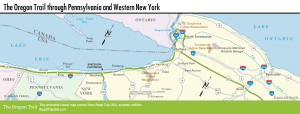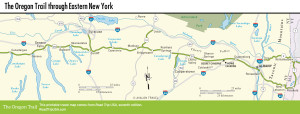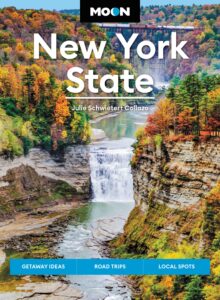Buffalo
Visiting Buffalo, NY
Founded as a Niagara frontier outpost in the early 1800s, Buffalo (pop. 256,304) exploded into a bustling shipping, manufacturing, and railroad center after the 1825 opening of the Erie Canal. For over a century, especially around World War I, Buffalo was the commercial and industrial linchpin between the Great Lakes, Canada, and the eastern United States. A shrinking population and the continuing departure of many factories and corporate headquarters to warmer cheap-labor climes has dented Buffaloans’ self-confidence over the past several decades. Still, the optimistic, made-in-Buffalo spirit captured so eloquently in nonfiction writer Verlyn Klinkenborg’s portrait of Polish-American bartender Eddie Wenzek, The Last Fine Time, lives on. Creative investment has adapted the city’s industrial infrastructure to modern times. Art studios and coffee shops have opened in old warehouse buildings, and the landmark grain elevators along the waterfront have been converted into an indoor rock-climbing gym. An excellent range of walking and kayaking tours are offered by the non-profit Explore Buffalo (716/245-3032.
A 15-minute drive from downtown up tree-lined Elmwood Avenue takes you to the grassy expanses and ponds of Delaware Park, designed by Frederick Law Olmsted, the landscape architect of New York City’s Central Park and Brooklyn’s Prospect Park. Across the road you’ll see the marble neoclassical structure that has housed The Buffalo History Museum (716/873-9644, Tues.-Sun., $10) since its construction in 1901 for the historic Pan-American Exposition.
A short walk from the Delaware Park brings you to the Frank Lloyd Wright-designed Darwin D. Martin House (125 Jewett Parkway, 716/856-3858, tours $22 and up), well worth a look for anyone interested in American architecture, especially after its recent restoration.
Buffalo’s world-class Albright-Knox Art Gallery is undergoing a massive renovation, planned for completion in 2022. Selections from its extensive collection of modern masterpieces, which includes Picassos, de Koonings, and Pollocks, can be seen at its temporary location (612 Northland Ave., 716/882-8700).
Between Buffalo and Niagara Falls, North Tonawanda (pop. 30,372) is a tough-looking factory town concealing one of the Buffalo area’s best-kept secrets, the Herschell Carrousel Factory Museum (180 Thompson St., 716/693-1885, Apr.-Dec., $7) a half-mile east of Hwy-265. Creator of much-loved landmarks at amusement parks from the Jersey Shore to Santa Monica, the barn-like factory houses a restored 1916 pulley-driven carousel and a stable of immaculately painted wooden steeds, zebras, roosters, ostriches, frogs, bears, and bulls hand-carved by the factory’s immigrant artisans for the countless carousels and kiddie rides turned out by the factory in its 1920s to 1940s heyday.
Where to Eat in Buffalo
Most of Buffalo’s many local clubs, films, and offbeat attractions are found in the funky, historic Allentown neighborhood around the junction of Elmwood Avenue and Allen Street, just north of downtown. The “World Famous” Anchor Bar (1047 Main St., 716/884-4083), “Birthplace of Buffalo Wings,” is here. Skip the bland Italian entrées in favor of the bar’s much-hyped specialty—the saucy, fiery, deep-fried chicken wings, served here since 1964. A long way out on Main Street, about 3 mi (4.8 km) from downtown near the SUNY Buffalo campus, are a pair of perfect Buffalo pit stops. Get breakfast (or veggie-friendly Lebanese lunch and dinner) at Amy’s Place (3234 Main St., 716/832-6666), or feast on delicious hot fudge sundaes or house-made candies at Parkside Candy (3208 Main St., 716/833-7540), an opulently decorated 1930s space that looks like a ballroom out of a Jane Austen novel.
Downtown Buffalo is energized by Bisons baseball and Sabres hockey games. During these games, the always-enjoyable Pearl Street Grill & Brewery (76 Pearl St., 716/856-2337) is even more packed than usual. There frequent farmers markets around the Filling Station at Larkin Square (719 Seneca St., 716/362-2665), in a resurgent industrial district about 2 mi (3.2 km) east of downtown.
Southeast of downtown, another unique Buffalo treat—the Beef on Weck sandwich, a moist and meaty version of a French dip, best eaten with a dash of horseradish—can be sampled at Schwabl’s (789 Center Rd., 716/675-2333) in West Seneca.
Accommodations in Buffalo
For a place to stay, most of the national chain motels are clustered east of town around I-90 and the Buffalo airport. The in-town Best Western (510 Delaware Ave., 800/780-7234 or 716/886-8333, $125 and up) is a bit higher-priced, but its central location saves driving time and grounds you smack in the middle of the city’s Allentown bar, restaurant, and club district; there’s also a comfy Hampton Inn & Suites (220 Delaware Ave., 716/855-2223, $129 and up) nearby. Downtown has the spacious Lofts on Pearl (92 Pearl St., 716/856-0098) in a wonderfully ornate old factory, while solo travelers on a smaller budget will appreciate the immaculate Hostel Buffalo-Niagara (667 Main St., 716/852-5222, $31 and up), with dorm beds in a historic downtown building.
Another arts-and-crafts aesthetic treasure is tucked away in the south Buffalo suburb of East Aurora. In the early 1900s, East Aurora was home of Roycroft Campus, a turn-of-the-20th-century arts-and-crafts community of furniture shops and studios, the crown jewel of which was recently restored and opened as The Roycroft Inn (40 S. Grove St., 716/652-5552 or 877/652-5552, $165 and up), a lovely hotel and restaurant.
For additional information and maps of Buffalo’s wealth of significant architecture (Louis Sullivan, H. H. Richardson, Eliel Saarinen, and Frank Lloyd Wright all completed major buildings here), contact the Buffalo-Niagara County visitors center (403 Main St., Ste. 105, 716/852-2356 or 800/283-3256).
New York Maps
















